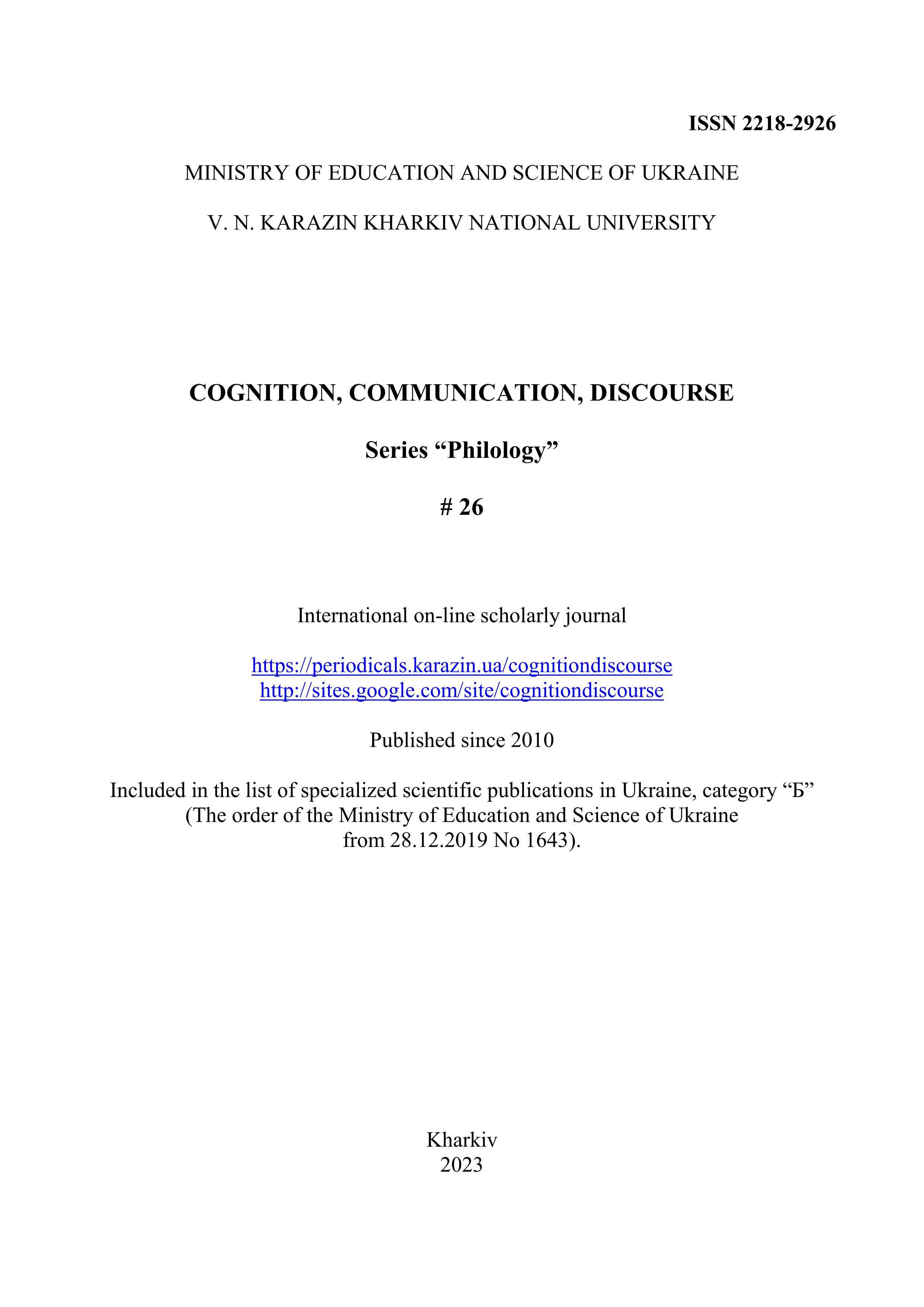The DIVIDED SELF metaphor and conceptualizations of the internal conflict in suicide notes
Abstract
This paper presents DIVIDED SELF metaphor analysis conducted drawing from the discourse of suicidal notes. The suicide notes represent a distinct genre because of its typical rhetorical structure and communicative purpose. In particular, the internal conflict experienced by the authors of suicidal notes makes this material suitable for an analysis of the metaphorical conceptualization of one’s own DIVIDED SELF. The research aims at modeling the conceptualization of one’s own conflicting SELF by the authors of the suicide notes and proposing approach to the metaphorical conceptualizations of the DIVIDED SELF as metaphtonymy, as well as describing their potential for representing the individual’s internal conflict. First, the cognitive framing of the inner SELF of the authors, divided into the instances of the Subject and the Self, was investigated. Second, in order to analyze metaphtonymic connections between the individual’s inner conceptualizations, the agentivity of the inner SELF conceptualizations was compared. Third, a metaphtonymic configuration of SELF conceptualizations was modeled and the potential of metaphorical framing of extreme psychological states through the metaphthonymic representation of the SELF described. The material of the study consisted of a corpus with a total size of 164,483 lexical units (the CEASE corpus combined with a self-assembled corpus of suicide notes). As demonstrated by the analysis, the aspect of the Self mainly acts as a fragmentation of the author in the DIVIDED SELF metaphor. That is, the study allowed to model metaphorical conceptualizations metaphtonymically and structure the stages of the formation of metaphtonymy through the visual illustrations.
Downloads
References
Brezina, V., Weill-Tessier, P., & McEnery, A. (2021). #LancsBox v. 6.x. [software]. Retrieved from http://corpora.lancs.ac.uk/lancsbox
Fauconnier, G., Turner, M. (2002). The way we think: Conceptual blending and the mind's hidden complexities. Basic Books.
Fata, I.A., Yusuf, Y.Q., Kamal, R., & Namaziandost, E. (2021). The characteristics of linguistic features enfolded in suicide notes. Journal of Language and Linguistic Studies, 17(2), 720-735. https://doi.org/10.52462/jlls.50
Galasiński, D. (2017). Discourses of men’s suicide notes: A qualitative analysis. London: Bloomsbury Academic.
Ghosh, S., Ekbal, A., & Bhattacharyya, P. (2020). CEASE, a corpus of emotion annotated suicide notes in English. In Proceedings of the Twelfth Language Resources and Evaluation Conference (pp. 1618-1626). Marseille: European Language Resources Association. Retrieved from https://aclanthology.org/2020.lrec-1.201
Ghosh, S., Ekbal, A., & Bhattacharyya, P. (2022). A multitask framework to detect depression, sentiment and multi-label emotion from suicide notes. Cognitive Computation, 14, 110-129. https://doi.org/10.1007/s12559-021-09828-7
Gómez, A. (2015). The DIVIDED SELF metaphor: A cognitive-linguistic study of two poems by Nabokov. International Journal of English Studies, 15(1), 97-113. https://doi.org/10.6018/ijes/2015/1/211121
Goossens, L., Pauwels, P., Rudzka-Ostyn, B, Simon-Vandenbergen, A.M., & Vanparys, J. (1995). By word of mouth: Metaphor, metonymy and linguistic action in a cognitive perspective. Amsterdam: John Benjamins. https://doi.org/10.1075/pbns.33
Goossens, L. (1990). Metaphtonymy: The interaction of metaphor and metonymy in expressions for linguistic action. Cognitive Linguistics, 1(3), 323-340.
Group Pragglejaz. (2007). MIP: A method for identifying metaphorically used words in discourse. Metaphor and Symbol, 22(1), 1-39. https://doi.org/10.1207/s15327868ms2201_1
Johnson, M. (1987). The body in the mind: The bodily basis of meaning, imagination, and reason. Chicago: University of Chicago Press.
Kövecses, Z. (2017). Conceptual metaphor theory. In E. Semino, & Z. Demjén (Eds.), Routledge Handbook of Metaphor and Language (pp. 13-27). London: Routledge.
Kövecses, Z. (2011). Recent developments in metaphor theory: Are the new views rival ones? Review of Cognitive Linguistics, 9(1), 11-25. https://doi.org/10.1075/rcl.9.1.02kov
Kövecses, Z. (2013). The metaphor–metonymy relationship: Correlation metaphors are based on metonymy. Metaphor and Symbol, 28(2), 75-88. https://doi.org/10.1080/10926488.2013.768498
Lakoff, G. (1996). Sorry, I’m not myself today: The metaphor system for conceptualizing the Self. In G. Fauconnier, & E. Sweetser (Eds.), Spaces, Worlds, and Grammars (pp. 91-123). Chicago: University of Chicago Press.
Lakoff, G. (1992). The contemporary theory of metaphor. In A. Ortony (Ed.), Metaphor and thought (pp. 202-251). Cambridge: Cambridge University Press. https://doi.org/10.1017/CBO9781139173865.013
Lakoff, G., & Johnson, M. (1980). Metaphors we live by. Chicago: University of Chicago Press.
Niemeier, S. (2012). Straight from the heart – metonymiс and metaphorical explorations. In A. Barcelona (Ed.), Metaphor and metonymy at the crossroads (pp. 195-213). https://doi.org/10.1515/9783110894677.195
Nöth, W. (n.d.). Metaphor of the Self. Anglisitk HS: Metaphor and metonymy. WS 1999/2000. Retrieved from https://www.audimax.de/fileadmin/hausarbeiten/anglistik/Hausarbeit_Anglistik_Metaphor_of_the_self_axh0048.pdf
Olsson, J. (2008). Forensic linguistics: An introduction to language, crime and the law. New York: Continuum.
Rany, M., Shalini, G., & Murthy, O. P. (2015). Suicide note: The last words. Forensic Medicine & Toxicology, 32(2), 35-41.
Roubidoux, S. M. (2012). Linguistic manifestations of power in suicide notes: An investigation of personal pronouns (Unpublished master’s thesis). University of Wisconsin, Oshkosh, WI, USA.
Samraj, B., & Gawron, J. (2015). The suicide note as a genre: Implications for genre theory. Journal of English for Academic Purposes, 19(1), 88-101. https://doi.org/10.1016/j.jeap.2015.04.006
Copyright (c) 2023 Nika Ananieva

This work is licensed under a Creative Commons Attribution-NonCommercial-NoDerivatives 4.0 International License.
Authors, who publish with this journal, accept the following conditions:
The authors reserve the copyright of their work and transfer to the journal the right of the first publication of this work under the terms of the Creative Commons Attribution License (CC BY), which allows other persons to freely distribute a published work with mandatory reference to the authors of the original work and the first publication of the work in this journal.
Authors have the right to enter into separate additional agreements for the non-exclusive dissemination of the work in the form in which it was published by this journal (for example, to post the work in the electronic institutions' repository or to publish as part of a monograph), provided that the link to the first publication of the work in this journal is given.
The journal policy allows and encourages the authors to place the manuscripts on the Internet (for example, in the institutions' repositories or on personal websites), both before the presentation of this manuscript to the editorial board and during review procedure, as it contributes to the creation of productive scientific discussion and positively affects the efficiency and dynamics of citing the published work (see The Effect of Open Access).




